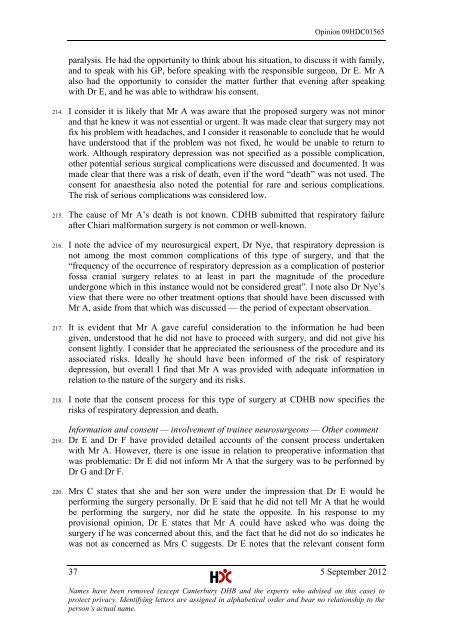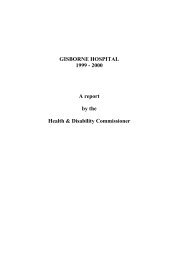09HDC01565 - Health and Disability Commissioner
09HDC01565 - Health and Disability Commissioner
09HDC01565 - Health and Disability Commissioner
Create successful ePaper yourself
Turn your PDF publications into a flip-book with our unique Google optimized e-Paper software.
Opinion <strong>09HDC01565</strong><br />
paralysis. He had the opportunity to think about his situation, to discuss it with family,<br />
<strong>and</strong> to speak with his GP, before speaking with the responsible surgeon, Dr E. Mr A<br />
also had the opportunity to consider the matter further that evening after speaking<br />
with Dr E, <strong>and</strong> he was able to withdraw his consent.<br />
214. I consider it is likely that Mr A was aware that the proposed surgery was not minor<br />
<strong>and</strong> that he knew it was not essential or urgent. It was made clear that surgery may not<br />
fix his problem with headaches, <strong>and</strong> I consider it reasonable to conclude that he would<br />
have understood that if the problem was not fixed, he would be unable to return to<br />
work. Although respiratory depression was not specified as a possible complication,<br />
other potential serious surgical complications were discussed <strong>and</strong> documented. It was<br />
made clear that there was a risk of death, even if the word ―death‖ was not used. The<br />
consent for anaesthesia also noted the potential for rare <strong>and</strong> serious complications.<br />
The risk of serious complications was considered low.<br />
215. The cause of Mr A‘s death is not known. CDHB submitted that respiratory failure<br />
after Chiari malformation surgery is not common or well-known.<br />
216. I note the advice of my neurosurgical expert, Dr Nye, that respiratory depression is<br />
not among the most common complications of this type of surgery, <strong>and</strong> that the<br />
―frequency of the occurrence of respiratory depression as a complication of posterior<br />
fossa cranial surgery relates to at least in part the magnitude of the procedure<br />
undergone which in this instance would not be considered great‖. I note also Dr Nye‘s<br />
view that there were no other treatment options that should have been discussed with<br />
Mr A, aside from that which was discussed — the period of expectant observation.<br />
217. It is evident that Mr A gave careful consideration to the information he had been<br />
given, understood that he did not have to proceed with surgery, <strong>and</strong> did not give his<br />
consent lightly. I consider that he appreciated the seriousness of the procedure <strong>and</strong> its<br />
associated risks. Ideally he should have been informed of the risk of respiratory<br />
depression, but overall I find that Mr A was provided with adequate information in<br />
relation to the nature of the surgery <strong>and</strong> its risks.<br />
218. I note that the consent process for this type of surgery at CDHB now specifies the<br />
risks of respiratory depression <strong>and</strong> death.<br />
Information <strong>and</strong> consent — involvement of trainee neurosurgeons — Other comment<br />
219. Dr E <strong>and</strong> Dr F have provided detailed accounts of the consent process undertaken<br />
with Mr A. However, there is one issue in relation to preoperative information that<br />
was problematic: Dr E did not inform Mr A that the surgery was to be performed by<br />
Dr G <strong>and</strong> Dr F.<br />
220. Mrs C states that she <strong>and</strong> her son were under the impression that Dr E would be<br />
performing the surgery personally. Dr E said that he did not tell Mr A that he would<br />
be performing the surgery, nor did he state the opposite. In his response to my<br />
provisional opinion, Dr E states that Mr A could have asked who was doing the<br />
surgery if he was concerned about this, <strong>and</strong> the fact that he did not do so indicates he<br />
was not as concerned as Mrs C suggests. Dr E notes that the relevant consent form<br />
37 5 September 2012<br />
Names have been removed (except Canterbury DHB <strong>and</strong> the experts who advised on this case) to<br />
protect privacy. Identifying letters are assigned in alphabetical order <strong>and</strong> bear no relationship to the<br />
person’s actual name.
















